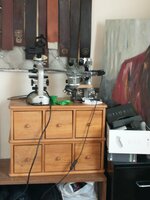The received wisdom about finishing seems to be that it's done differently on jnats vs coticules. I'm trying to guess at why.
My experience with my coti is that to finish, it's best done under running water with no slurry.
But for jnats, its different. To finish, keep some slurry, but keep doing laps and wear down the slurry.
From the electron photos I have seen on Science of Sharp, the silica particles in jnats don't fragment into small pieces. But despite this, jnats do "behave" over the lapping period as if they are getting finer. And we can actually see the groove lines getting shallower.
So it must be that the particle's sharp edges are becoming dulled with use. That makes the jnat particle cut as if it has become a finer particle. The particle is the same size, but the sharp edges sticking out from it are becoming dulled and it is no longer cutting as deep into metal.
I wonder. Are the hard garnets in cotis so hard that they just don't become dulled with use? They keep cutting deep grooves, so eventually you just have to wash the slurrry away and just lap on the hard coti surface, like the slippery surface of a black ark?
My experience with my coti is that to finish, it's best done under running water with no slurry.
But for jnats, its different. To finish, keep some slurry, but keep doing laps and wear down the slurry.
From the electron photos I have seen on Science of Sharp, the silica particles in jnats don't fragment into small pieces. But despite this, jnats do "behave" over the lapping period as if they are getting finer. And we can actually see the groove lines getting shallower.
So it must be that the particle's sharp edges are becoming dulled with use. That makes the jnat particle cut as if it has become a finer particle. The particle is the same size, but the sharp edges sticking out from it are becoming dulled and it is no longer cutting as deep into metal.
I wonder. Are the hard garnets in cotis so hard that they just don't become dulled with use? They keep cutting deep grooves, so eventually you just have to wash the slurrry away and just lap on the hard coti surface, like the slippery surface of a black ark?
